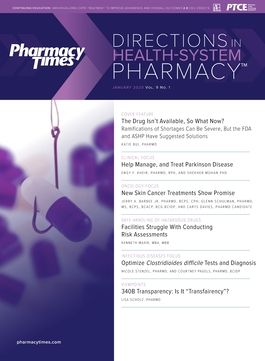Publication
Article
Pharmacy Practice in Focus: Health Systems
340B Transparency: Is It "Transfairency"?
Author(s):
Covered entities, government, and pharma companies could reach a compromise to benefit stakeholders.
The health care industry is changing more rapidly than it has in decades, and every change has a ripple effect. To best understand the nuances of what has been happening in the 340B program in recent years and the rationale behind the increased call for transparency, we must first examine the backdrop of health care’s overall big picture.
The developments and debates surrounding the 340B program read like a microcosm of the larger health care landscape. Economics, politics, social factors, and technology are all at play within 340B, and the program can sometimes serve as a scapegoat for other issues, such as drug prices, political polarization, and social discontent with health care delivery.
More new bills aimed at curtailing and regulating the 340B program have been introduced in the past 2 years than at any other time in the program’s 27-year history.
For a while, it seemed that the Trump administration was focusing on the 340B program as a way to reduce drug prices, despite the fact that the program accounts for only about 1% of total drug spending in the United States each year.1
In addition to the administration’s focus on drug prices, some other factors that contribute to the volatility of the 340B program are as follows:
Broadening consulting and technology options.
As companies see the program’s complexity increase, more consultants and more technology choices become available, and the cost of those services and technologies must be factored into the overall cost of managing the 340B program.
Community health center expansion.
Federally qualified health centers (FQHCs) are community-based health care providers that receive funds from the Health Resources and Services Administration’s (HRSA’s) Health Center Program to provide primary care services in underserved areas. As more FQHCs are created nationally, use of the 340B program is increasing.2
Congressional interest.
Mentions of the 340B program in congressional hearings and committee meetings in both the House and the Senate have increased in the past few years.
Increased government and manufacturer oversight.
Audits of 340B-covered entities by both HRSA and pharmaceutical companies have increased in recent years, aligning with the administration’s call for increased transparency and reduced health care costs.
Merger and acquisition activity and vertical integration.
As health systems continue to acquire independent hospitals and practices, retail pharmacy giants acquire payers, and tech companies and retailers from Amazon to Google to Uber begin growing roots in the health care industry, the 340B program will inevitably be affected.
Multiple contract pharmacy arrangements.
Covered entities can have relationships with multiple contract pharmacies, which complicates the nature of tracking and reporting program savings yet can improve patient access through online accessibility and specialty pharmacy.
Pharmacy benefit manager (PBM) reimbursement changes.
PBMs are increasingly changing the way they reimburse pharmacies. Recently, PBMs have tried to deny rebates for drugs in the 340B program to pharmacies that contract with 340B providers.3,4
Stretched resources.
Hospital margins are getting slimmer, and resources are getting scarcer. Yet as complexity around 340B compliance and reporting increases, covered entities will need more, not fewer, resources to effectively optimize and manage the program.
With all this volatility, it is no surprise that 340B seems to have reached a boiling point. It is therefore more important than ever for covered entities to be aware of the health care landscape and to work with partners that can offer both cutting-edge technology and industry expertise to help optimize 340B program participation. It is too easy for conflicts of interest and potential channel partners to go unnoticed against this backdrop, as the lines between private and public sector involvement continue to blur.
Call for Transparency
An overarching call for transparency has gone hand in hand with the government’s focus on drug prices. On the surface, this seems advisable. Covered entities, federal governing bodies, and pharmaceutical manufacturers should all be able to see with ease how and why the 340B program is working and identify areas that need improvement. However, in practice, some of the demands for transparency, including new bills aimed at curtailing the program and reimbursement cuts that have since been ruled unlawful, have crossed the line from practical to burdensome and, in some cases, even harmful to the patients for whom the program was intended.
Yet transparency is possible without undoing all the good that the program has achieved over the past 27 years.
Here are some practical standards for transparency that covered entities could deliver while still maintaining the integrity of the program and serving vulnerable populations:
- Elimination of anticompetitive behavior
- Equal reporting by other involved parties including manufacturers
- Protection of confidential and proprietary information
- Review of all appropriate data points that reflect the covered entities’ true cost burden and benefit received
With a little common sense and a dash of empathy for vulnerable patients, covered entities, the government, and pharmaceutical companies could potentially reach a compromise around transparency in which no stakeholder would be made to feel like the “losing” side.
The second and final part of this series in the March issue will look at how transparency should go both ways and what covered entities can do to prepare for increased reporting requirements.
REFERENCES
- Dobson A, Murray K, DaVanzo JE. Assessing the financial impact of the 340B Drug Pricing Program on drug manufacturers. 340B Health website. 340bhealth.org/files/340B_Financial_Impact_7_17.pdf. Published July 2017. Accessed December 4, 2019.
- Federally qualified health centers. Health Resources & Services Administration website. hrsa.gov/opa/eligibility-and-registration/health-centers/fqhc/index.html. Updated May 2018. Accessed December 4, 2019.
- Scholz L. February 340Buzz — industry comes together at 340B winter conference. Sentry Data Systems website. sentryds.com/february-340buzz-industry-comes-together-at-340b-winter-conference/. Published February 19, 2019. Accessed December 4, 2019.
- Scholz L. August 340Buzz — HHS continues to pursue Medicare Part B cuts. Sentry Data Systems website. sentryds.com/august-340buzz-hhs-continues-topursue-medicare-part-b-cuts/. Published August 21, 2019. Accessed December 4, 2019.







